ADDRESS
421-431
YEAR BUILT
1894
STREET
Menzies
AREA
Victoria
PROTECTION
Registered Heritage
ARCHITECT OR BUILDER
William Ridgway Wilson / H. James
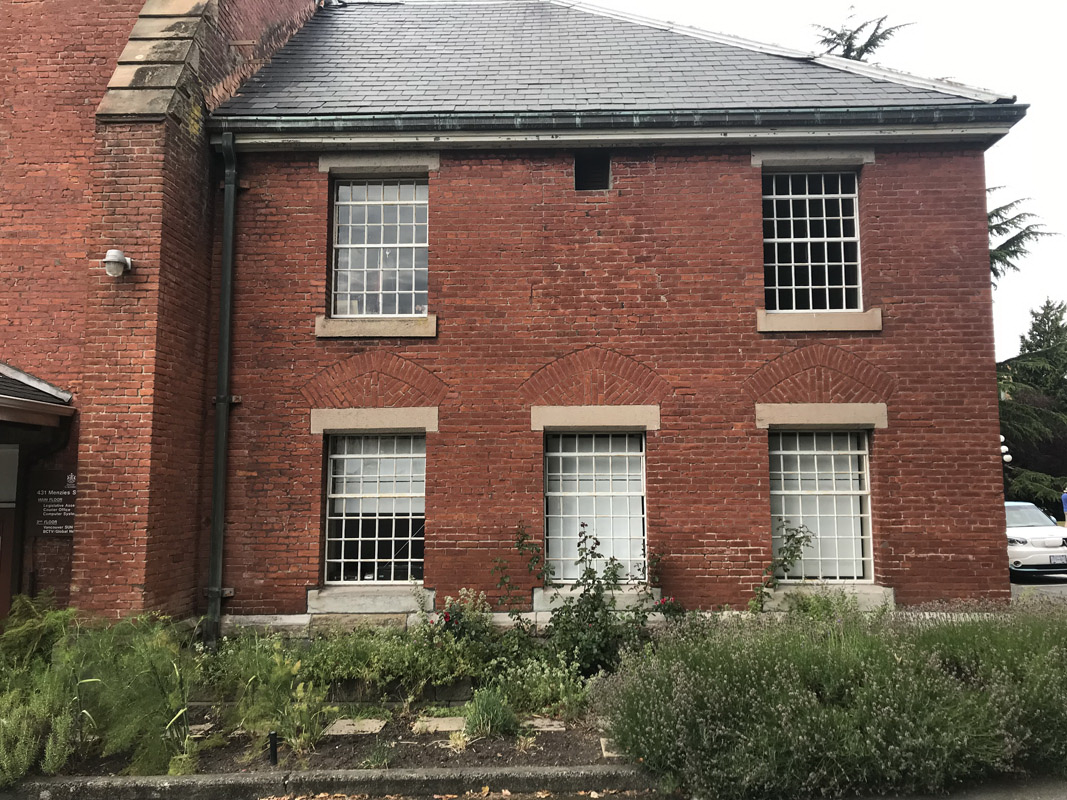
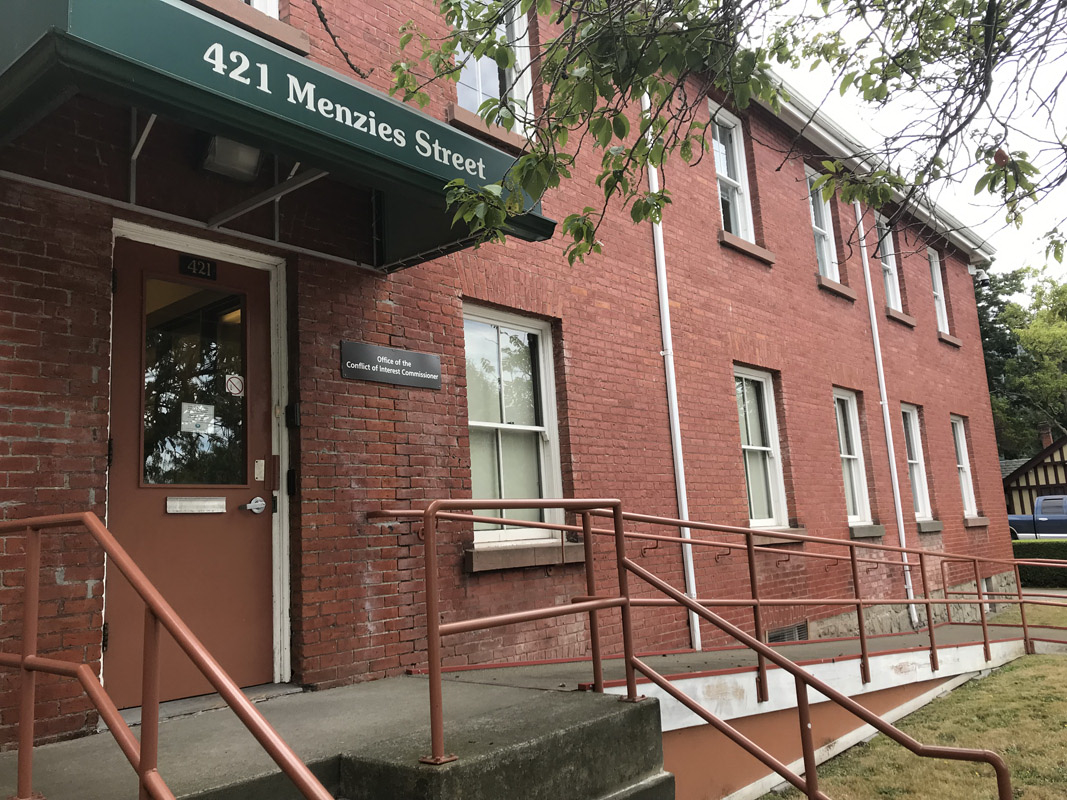


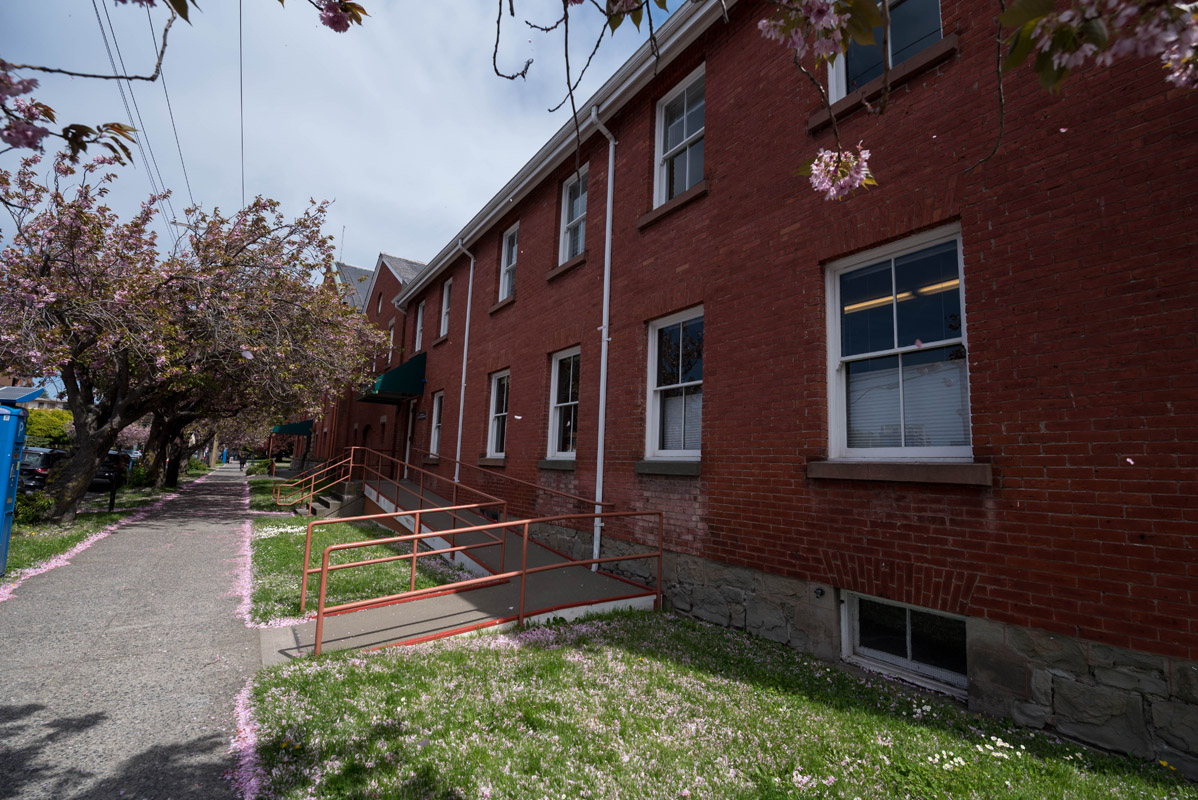
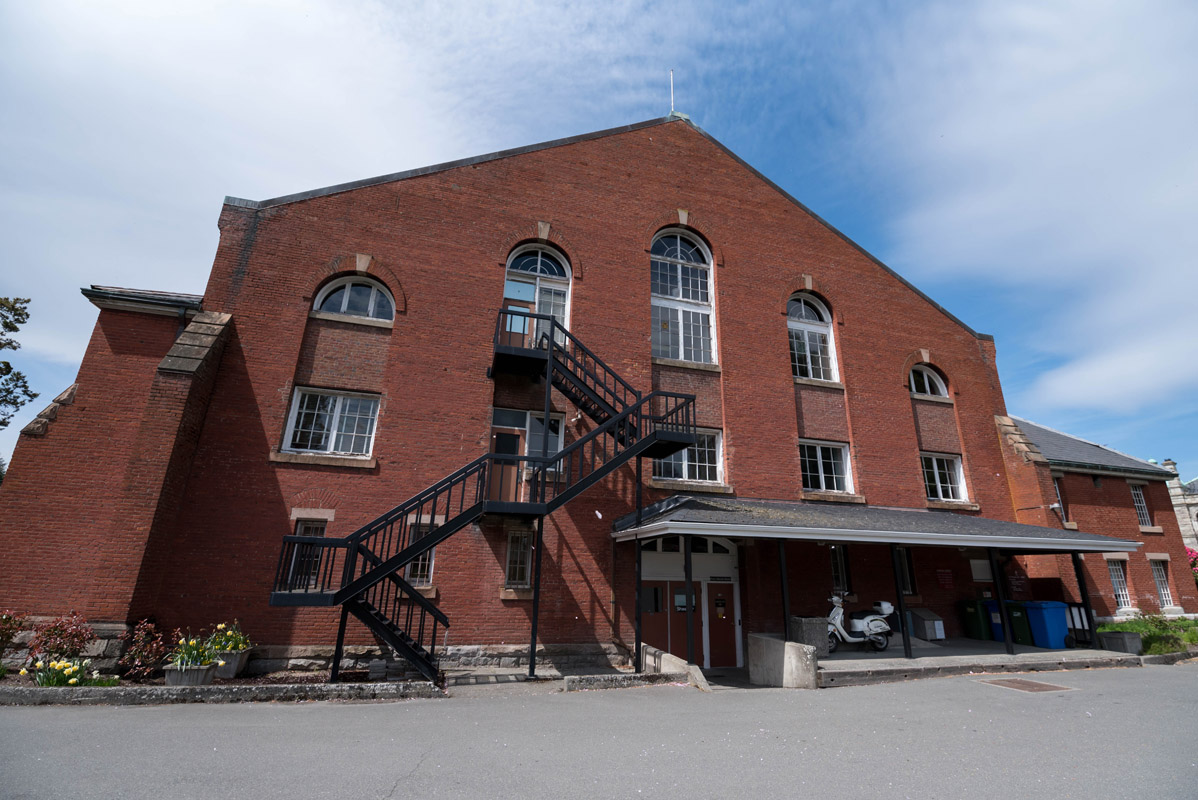
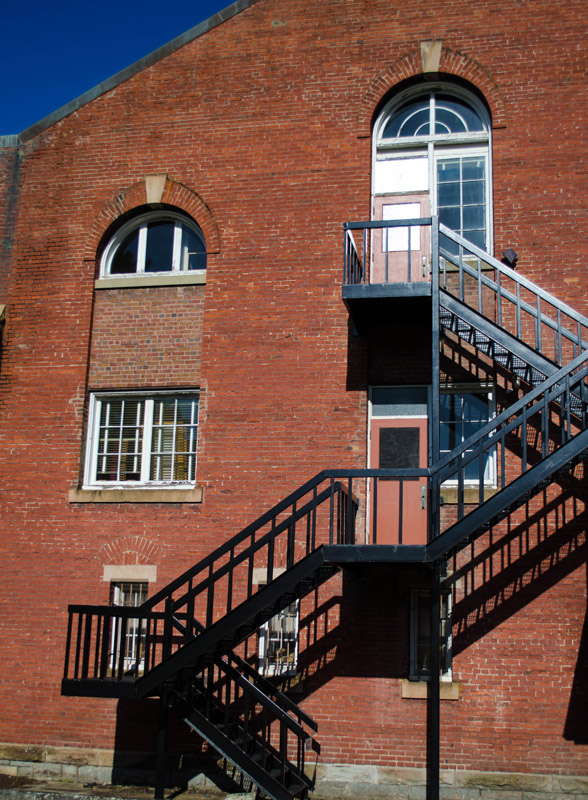
421-31 Menzies Street
(ex-115-125, also 417-419-423 Menzies St)
Drill Hall & Ordinance Stores (& caretakers’ homes)
Built 1891-93
Heritage-Registered/Institutional
For: Federal Department of Militia & Defence
Designer/Engineer: Henry James
Supervising Engineer: Francis Clark Gamble, CE
Contractor: Maurice Humber & Son
ARCHITECTURE:
This impressive complex is built of red brick with cut stone trim. The Drill Hall, which was originally two-storied, is the most prominent building. This symmetrical, now-three-storied, front-gabled, Romanesque Revival structure has five bays on both the front and the rear. The upper storeys of the five bays have round-headed windows capped by voussoirs and keystones. Many of the windows throughout the building were originally multi-lights. A shed-roofed structure between hip-roofed ends is attached to the full length of the building’s left side. The central front entrance comprises a wide, plain frieze, a cornice above a pair of windows, and truncated ashlar columns of sandstone either side of the door. There are sandstone-trimmed buttresses at the rear and right side, but some are now obscured by side additions. The foundation is of random, rusticated ashlar blocks of granite with sandstone quoins beneath a sandstone water table. The chimneys have been removed, but the roof is still slate.
To the right of the Drill Hall is a smaller, front-gabled, two-storey, symmetrical brick building with three bays and no foundation; they are joined by a two-storey pink stucco addition. A round louvred vent in the gable is above the now-bricked-in, segmentally-arched entrance door. The window sills and headers are sandstone. A third two-storey building to the right has six bays, is hip-roofed and asymmetrical. Its entrance is in the extreme left bay. The basement of random sandstone blocks still retains some patches of parging, marked to resemble more regular blocks. The rear right corner of 431 Menzies St is cut off at an angle; the rear itself is irregular. All windows have concrete sills and brick voussoirs. The chimney has been cut short.
ORIGINAL OCCUPANTS:
In the 1890s Victoria was feeling left out by all the building activity on the mainland, and steps were taken to enhance some of the city’s institutional structures. When City Council discussed the possibility of a new drill hall in 1890, Ald. Wilson commented “the Dominion buildings in Victoria are the shabbiest government buildings in Canada.” After City Council approved the payment of $5,000 towards the construction of the new drill hall, plans were provided by the Militia Department for a large structure for the 5th British Columbia Artillery Regiment. Henry James, an engineer with the Federal Department of Public Works (DPW), designed the Drill Hall while with the newly-established Engineering Branch of the Department of Militia and Defence. Tenders were called in March, 1892, and the existing 1874 drill shed, was demolished. Largely through the efforts of Col E.G. Prior (729 Pemberton Rd / 620 St. Charles St, Rockland), Commanding Officer of the BC Battalion of Garrison Artillery, it was finally completed in 1893. The work was supervised by Francis Gamble, resident engineer with the BC DPW, and the drill hall was opened 24 January 1894 by Lieut-Gov Edgar Dewdney (1759 Rockland Av).
This building was also used as a community hall on Saturday nights to host local events such as basketball games, ladies’ hockey, girls’ fencing, regimental concerts and ceremonies, special events and balls on behalf of local organizations, children’s exhibitions, and Biograph films from 1900 (special matinees for 25 cents). On 13 November 1895 a State Ball was held to welcome the Gov-Gen and his wife, Lord and Lady Aberdeen.
Source: Victoria Heritage Foundation LINK
Times Colonist, January 25, 2022
Uncertain future for 1890s Armouries building in legislative precinct; tear down or repair?
Carla Wilson
Complex is in City of Victoria’s heritage register; study being commissioned to provide options The future of the old brick Armouries Drill Hall is once again under review as part of a long talked about restoration of buildings in B.C.’s legislative precinct.
Built in 1891-1893, the complex is on the City of Victoria’s heritage register and remains in use today with offices for legislative assembly staff and media outlets. It faces Menzies Street and is southwest of the main legislature building in the James Bay neighbourhood.
The legislative assembly issued a request late last year for bids to look at the building.
Proposals are being evaluated. It is expected that the winning consultant from the engineering/architecture community will be awarded the work early this year, likely by mid-February, said Paul Holman, of AHA Creative Strategies, the public relations agency for the Capital Planning and Development team on this project.
The bid document states the province was seeking proposals to replace the building. But Holman said in a statement that the decision about whether to replace the building with a new structure or to carry out an upgrade to the Armouries has not yet been made
n 2017, the idea was floated of tearing down the Armouries to make way for a new building to serve as a backup to the main legislature building in case it collapsed during an earthquake.
That building, at more than 100 years old, has been deemed to be at high risk in a major earthquake. Earlier estimates have said that making it safe would cost in the hundreds of millions of dollars.
In the latest look at the legislative precinct, the Armouries contract will start with a concept and design stage for possible options and uses. That work is expected to be completed this fall, Holman said.
Options will then be examined to determine whether the building should be retained.
“Based on the outcome of this analysis and business case, a final decision will be made as to what is the most strategic and sustainable approach, perhaps late winter,” Holman said.
The building is considered safe to work in now, but is “still at serious risk in the event of a major seismic event,” he said.
The Armouries is 59,000 square feet in all, but has just 16,500 square feet of usable space.
It is unclear what might be in the works regarding the rest of the legislative precinct. “We cannot share the reports because of security concerns as the reports provide detailed information on aspects of the building that could be misused or misinterpreted by external individuals or groups,” Holman said.
The Victoria Heritage Foundation’s website said in the 1890s Victoria was feeling left out by all the building activity on the mainland and steps were taken to enhance some of the city’s institutional structures, which led to the construction of the Armouries.
The complex was built as a drill hall, with space for ordnance storage and with a home for the caretaker. The drill hall was used as a community hall on Saturday nights, the foundation said.
It provided space for events such as basketball games, ladies’ hockey, girls’ fencing, regimental concerts and ceremonies and special events. In November 1895, a state ball was held to welcome Gov. Gen. John Campbell Hamilton-Gordon, Earl of Aberdeen and Lady Aberdeen.
cjwilson@timescolonist.com
Daily Colonist, February 1, 1891.
The Drill Shed
The city clerk submitted a communication from the Deputy Adjutant-General, asking what assistance the city would give, either in money or land, towards the new drill hall.
The Mayor explained the situation on this subject as between the Militia Department and the Corporation. He also cited the provisions of the law empowering corporations to make grants and bonuses.
Ald. Renouf moved, seconded by Ald. Smith: Whereas it is expedient to assist in the maintenance of a militia corps in the city, and inasmuch as it has been a general rule of the Dominion government not to erect drill halls in any city unless a certain assistance is contributed for that purpose, therefore, it is
Resolved, That this Council is of the opinion that the sum of $5,000 should be contributed by this city towards that end; and as the municipal act does not contemplate a gift of money for such an object it is considered that the municipal act should be amended so that a sum of money could be donated by the city in lieu of land, and that the clerk be instructed to forward a copy of this resolution to Lieut. Col. Holmes, and that the members of this city to the local legislature be asked to support an amendment in this direction..
The resolution was carried.
Daily Colonist, April 1, 1892.
Victoria’s New Drill Shed.
The plans and specifications of the new drill shed, to be erected on the site of the present structure, are on view at the offices of Mr. F. C. Gamble, C.E., in the post office block, and today will be inspected, no doubt, by many contractors, who will figure on the job. The building will be imposing in appearance, spacious, and fitted up so as to secure the greatest possible amount of comfort and convenience within the area allotted. It will be of stone and brick, wide and massive looking main entrance. The front elevation is pretty and substantial, the doorway and large windows the and encased in solid stone masonry. On the ground floor provision is made for five armouries, each 25 x 25, feet, sergeant’s room, Quarter Master’s store rooms, orderlies and officers rooms, besides the drill hall. A commodious stairway needs to the shooting gallery on the first floor, which runs almost the full length of the building, with every convenience for markers and spectators. On this flat good provision is made for the band; also a reading room, officers room, anteroom, and a couple of spare apartments, which may be used for committee rooms or other purposes. The grounds surrounding the building have been admirably laid out. Tenders will be received up to the 22nd, inst., And as soon as the contract is awarded, work will commence without delay.
Daily Colonist, May 1, 1892
Officially Notified.
Ald. Humber, yesterday, received official notification of having been awarded the contract for the new drill shed. He will commence work as soon as the documents are signed.
Daily Colonist, May 26, 1892.
The New Drill Shed.
As there is a considerable quantity of ammunition, etc., stored in the old drill shed, the contractor is not disposed to commence operations on the new structure until all danger is removed. The work of clearing out will begin in a few days, and as soon as this is completed, Humber & Sons will have the old place torn down and make a start on the new and more sightly building, which will be ready for occupation early next spring.
Daily Colonist, June 19, 1892.
The Long Promised Drill Hall.
The old drill shed came down with a crash yesterday morning, and by Wednesday ground will be broken for a new structure.
Daily Colonist, October 11, 1893.
Thompson, Christie and Company, of the city, being the lowest tenderers, from the Public Works department, whether they are prepared to take the contract for the completion of the new drill hall, and have in reply signified their willingness to go on with the work. There was a report in the city that the lowest tenderers and reconsider the matter and would allow their deposit to be forfeited, but one of the firm stated to the Colonist yesterday that the report has no foundation in fact.
Daily Colonist, January 12, 1894.
The drill hall will be open to the public this evening and tomorrow night. There will be a field gun drill both evenings, and on Monday and Tuesday evening the guard of honour for next Thursday will parade for infantry drill. Last night, after drill, several men were sworn in, and all who take an interest in the militia are cordially invited to inspect the new quarters on the above evenings.
Daily Colonist, January 25, 1894.
THE NEW DRILL HALL.
Formally Opened by the Lieutenant Governor. Addresses by the Bishop and Captain Hallet, R. N.
It did not need the finely engraved invitation cards for the promise of a selected musical program to awaken an interest in the formal opening of the new drill hall by His Honour Lieutenant-Governor Dewdney last evening; the interest was general, without any outside inducement, in the mere fact of the volunteers having someplace which they could creditably give the name of home. The consequence was that the drill hall was far too limited to hold the congregation of admirers of the Queen’s uniform, the companies of the battalion being cramped for room and going through the ordinary drill. There was a full turnout of both officers and men, and a very good show was made. After the usual parade the men were lined up, when they were inspected and addressed by His Honour we express the pleasure it gave him to be present, and, in outlining the history of the effort to obtain a suitable drill hall in Victoria, expressed his gratification at the completeness of the institution. It might not be constructed on as elaborate a scale at some of the other structures of its kind in Eastern Canada, but it was one that the men had good reason to be proud of. He was surprised to hear that the Government had transferred to the battalion only the bare building, when he found that the men had put their hand so earnestly to the plow that already the various quarters were comfortably furnished. Of course they might not be complete, but that was merely a matter of time. Therefore he congratulated the volunteers on the interest they have manifested in their new home, and he further congratulated the citizens of Victoria in having such a fine structure for the brigade. There was no small credit due to members of Parliament in the matter, especially to the gallant Colonel, who had worked with the greatest of zeal in obtaining this beautiful home for the B.C.B.G.A. In conclusion he had great pleasure in declaring the hall open.
His Lordship Bishop Perrin then came forward and was greeted with the utmost warmth. The right reverend gentleman was proud to say that he had worn the volunteer uniform in the town where he lived in England. After a few humorous remarks, His Lordship addressed himself directly to the men and the duties that lay before them. One volunteer is worth ten pressed men, said the Bishop, and he proceeded to contrast the times in England when men were pressed into service with the period when volunteers left their homes and placed themselves in readiness to defend their country. It is this movement that has formed a grand chapter in the history of Britain and her colonies. But a great duty and responsibility rested on the volunteers; it was their province to set an example, not only when they wore their uniforms, but in their every-day life to raise the standard of morality, honesty, honour and truth.
Captain Hughes Hallett, R. N., Remarked that, because sails and masts were going out of fashion, and smokestacks and guns coming in, people thought that sailors had to do a good deal of soldiering. Well, they had, and had been chaffed a great deal about it; but afterwards those chaffers came along and said the sailors didn’t do their soldiering so badly after all. It was the same with the volunteers; they were chaffed, but they could live it down. They were called “amateur soldiers,” but it was the amateur soldier that rendered unnecessary in Britain and her colonies, the custom of conscription that obtained in almost all other countries. (Hear, hear.) One thing had to be observed, and that was a spirit of what is called comradeship. An instance of this was witnessed in Esquimalt the other day when a lad of an officer saw comrade from the ranks struggling in the water, and did not hesitate a moment in going to his rescue. The captain also referred to the famous “diehards” of the Peninsular war, as lessons to the men before him to sink individually for the sake of the general success. To those not in the ranks he would say that it was their duty also to foster this movement, which had for its object their safety and welfare. The volunteers save their pockets, as well as their lives, in as much as but for the volunteers the people would have to pay heavy taxes to maintain an army for the protection of the country. Therefore he exhorted the people to do their duty, and the soldiers, there is, reminding them of the words of one of the greatest sailors who ever floated, who said that “England expects every man to do his duty.” (Cheers.)
This closed the formalities of the evening and the large concourse of people proceeded to inspect the building, listening at the same time to the music discoursed by the band, the program of which has already appeared.
Daily Colonist, December 17, 1896.
Militia Men and the Poll Tax.
To the Editor: – I was very glad to see in your issues of 15th and 16th inst., the letters from “Militia Man” “Miles,” in which they press the claims of the militiamen of this province to exemption from the poll or a revenue tax. Now that I have resigned the command of the militia in BC after holding it for 8 years I may, I hope, be allowed to say a word or 2 on this subject without being accused of bias in favour of the “boys in blue.”
It seems to me that it is a very little thing that the citizens of the different municipalities are asked to do in return for the great benefits derived from the presence in their midst of an efficient and loyal body of trained men. The public are always very good to make use of the militia as a drawing card on all public occasions to bring visitors to spend money in the towns (and those long parades and sham fights are no child’s play); but it is like drawing teeth to try and collect a few dollars for the benefit of the Regiment or even for their splendid band.
As “Militia Man” very truly says, “they work hard and get nothing for it,” as a government pay goes to buy helmets and leggings, articles that I live in hope of yet seen provided by the Militia department as they should be. They are the pick of the young men of our cities, being young, active, healthy and patriotic, as is amply shown by the time and work they put in without any hope of reward except that best of all rewards, the knowledge that they are doing their duty to their Queen and country. But the “laboreris worthy of his hire,” and so surely it is not too much to ask of the citizens of this province that they should show their appreciation of these efforts by granting these young men a slight privilege such as is now asked. It is not the intrinsic value of the tax that they care so much about as it is the open acknowledgement thereby expressed of the fact that their services are thought worthy of the people’s thanks.
There are not so many of them at the exemption of this tax would make any great inroad into the city treasuries, whilst at the same time it would be a slight incentive to young men to join the ranks, and thus make the duties of recruiting a little less arduous than at present. The 5th Regiment will compare most favourably with any Regiment of militia, either in Great Britain or Canada, not only in physique and pluck, but in knowledge of drill, general smartness and interior economy. Great Britain looks to them to man the guns at the Esquimalt forts in case of trouble, and in such case they will share the dangers equally with the fine fellows compose the small body of Imperial troops now at the barracks. Such be in the facts, I would ask every man, aye and every woman, too, who has the welfare of the Empire at heart, to assist demolition by moulding public opinion in favour of granting them this small boon. It is done in England and in Eastern Canada, so why not here?
“Miles” is right in saying you cannot send your boys to a better place in the evening than the drill hall. There they find manly exercises, jovial but sober companions, comfortable reading rooms and then education of respect for oneself and for “those in authority over you.” This idea of exemption from poll tax is nothing new, as I have as commanding officer several times applied to some of the local members to bring in the necessary legislation, and I was always given the greatest encouragement by promises that somehow or another nothing materialized. Now is the time before the legislature meets to again urge the matter.
E. G. Prior.
Times Colonist, August 21, 1982.
Victoria Landmarks
The drill hall on Menzies Street, behind the legislative buildings, was opened on Jan. 10, 1891. It replaced an earlier drill shed built in 1871 at a cost of $1,500. Before that time, the Militia used the old 72 x 32 ft. James Bay barracks constructed in 1859 similar in style to the original legislative buildings (the “Birdcages”).
Located on the east side of the complex, the single-store y brick barracks had a 48 x 24 ft. frame mess and storehouse attached. It was first occupied from Aug. 10, 1859, until March 21, 1860, when the marines came over from New Westminster aboard the steamship Otter at the time of the San Juan Island dispute.
In 1861, the Victoria Rifles drilled in the building until they were disbanded the following year. It was in 1862 that some 60 young women arrived on the brideship Tynemouth and were housed in the barracks for a short while. The “Rifles” were reformed in 1864 and once again drilled there. The building survived until 1898 when it was demolished as were four of the five birdcages to make room for the new legislative buildings.
Designed by the Militia Department, the Menzies Street Drill Hall was 75 by 160 feet and had a two-store y leant o extending the length of the building. The ground floor had five armories, a gun shed, officer’s and orderly’s rooms and a quartermaster’s stores. The first floor contained a band room, reading and store rooms. Two cottages and a warehouse were built adjacent on the south side but became attached later.
In 1914, the much larger present Bay Street Armories were constructed and the provincial government took over the buildings on Menzies Street for of Education text book branch. Provincial Police headquarters and, more recently, the Motor Vehicle Branch, for which the old building is best known.
Contributed by Geoffrey Caste for the Victoria Branch of the B.C. Historic Association
